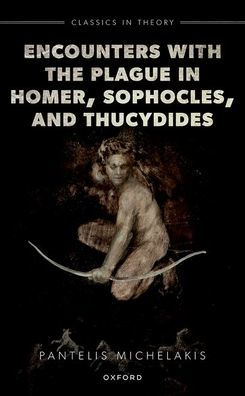Encounters with the Plague in Homer, Sophocles, and Thucydides
Encounters with the Plague in Homer, Sophocles, and Thucydides explores three of the earliest, and most influential, accounts of plague visitations in Western literature: Homer's Iliad book 1 (1-487), Sophocles' Oedipus the King (esp. 1-215), and Thucydides' History of the Peloponnesian War book 2 (esp. 47.3-54).
The question at the core of this study is how a destructive force within narrative becomes a creative force for narrative itself: both in terms of the formation of narrative and in narrative's encounter with its readers and spectators as the hosts that will ensure its dissemination and its survival through time. The three accounts of plague visitations under discussion matter as examples of a particular type of narrative event associated with crisis. In all three of them, the plague spreads through seemingly disparate but closely interconnected social, material, and technical networks: different linguistic domains, structures of narrative space and time, routes of knowledge and affect, and biological and socio-political bodies. Thematically, the plague is a disruptive force that breaks down distinctions between and across such networks. At the same time, however, it is also a generative force that shows the capacity of narrative to expose the heterogeneous parts of such networks and the complex interconnections within and between them.
By emphasizing the disruptive, invasive force of such narratives, with their power to spread like epidemic disease, this book offers a way of thinking through the anxieties generated by exposure to technical and artistic skill.
1147388107
The question at the core of this study is how a destructive force within narrative becomes a creative force for narrative itself: both in terms of the formation of narrative and in narrative's encounter with its readers and spectators as the hosts that will ensure its dissemination and its survival through time. The three accounts of plague visitations under discussion matter as examples of a particular type of narrative event associated with crisis. In all three of them, the plague spreads through seemingly disparate but closely interconnected social, material, and technical networks: different linguistic domains, structures of narrative space and time, routes of knowledge and affect, and biological and socio-political bodies. Thematically, the plague is a disruptive force that breaks down distinctions between and across such networks. At the same time, however, it is also a generative force that shows the capacity of narrative to expose the heterogeneous parts of such networks and the complex interconnections within and between them.
By emphasizing the disruptive, invasive force of such narratives, with their power to spread like epidemic disease, this book offers a way of thinking through the anxieties generated by exposure to technical and artistic skill.
Encounters with the Plague in Homer, Sophocles, and Thucydides
Encounters with the Plague in Homer, Sophocles, and Thucydides explores three of the earliest, and most influential, accounts of plague visitations in Western literature: Homer's Iliad book 1 (1-487), Sophocles' Oedipus the King (esp. 1-215), and Thucydides' History of the Peloponnesian War book 2 (esp. 47.3-54).
The question at the core of this study is how a destructive force within narrative becomes a creative force for narrative itself: both in terms of the formation of narrative and in narrative's encounter with its readers and spectators as the hosts that will ensure its dissemination and its survival through time. The three accounts of plague visitations under discussion matter as examples of a particular type of narrative event associated with crisis. In all three of them, the plague spreads through seemingly disparate but closely interconnected social, material, and technical networks: different linguistic domains, structures of narrative space and time, routes of knowledge and affect, and biological and socio-political bodies. Thematically, the plague is a disruptive force that breaks down distinctions between and across such networks. At the same time, however, it is also a generative force that shows the capacity of narrative to expose the heterogeneous parts of such networks and the complex interconnections within and between them.
By emphasizing the disruptive, invasive force of such narratives, with their power to spread like epidemic disease, this book offers a way of thinking through the anxieties generated by exposure to technical and artistic skill.
The question at the core of this study is how a destructive force within narrative becomes a creative force for narrative itself: both in terms of the formation of narrative and in narrative's encounter with its readers and spectators as the hosts that will ensure its dissemination and its survival through time. The three accounts of plague visitations under discussion matter as examples of a particular type of narrative event associated with crisis. In all three of them, the plague spreads through seemingly disparate but closely interconnected social, material, and technical networks: different linguistic domains, structures of narrative space and time, routes of knowledge and affect, and biological and socio-political bodies. Thematically, the plague is a disruptive force that breaks down distinctions between and across such networks. At the same time, however, it is also a generative force that shows the capacity of narrative to expose the heterogeneous parts of such networks and the complex interconnections within and between them.
By emphasizing the disruptive, invasive force of such narratives, with their power to spread like epidemic disease, this book offers a way of thinking through the anxieties generated by exposure to technical and artistic skill.
130.0
Pre Order
5
1

Encounters with the Plague in Homer, Sophocles, and Thucydides
272
Encounters with the Plague in Homer, Sophocles, and Thucydides
272Hardcover
$130.00
130.0
Pre Order

Product Details
| ISBN-13: | 9780198844105 |
|---|---|
| Publisher: | Oxford University Press |
| Publication date: | 02/15/2026 |
| Series: | Classics in Theory Series |
| Pages: | 272 |
| Product dimensions: | 6.50(w) x 1.50(h) x 9.50(d) |
About the Author
From the B&N Reads Blog
